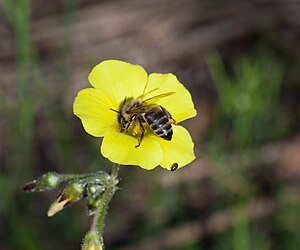Cape bee
| Cape bee | ||||||||||||
|---|---|---|---|---|---|---|---|---|---|---|---|---|

Cape bee ( Apis mellifera capensis ) |
||||||||||||
| Systematics | ||||||||||||
|
||||||||||||
| Scientific name | ||||||||||||
| Apis mellifera capensis | ||||||||||||
| Eschscholtz , 1821 |
The cape bee ( Apis mellifera capensis ) is the southernmost of all subspecies of the western honey bee . Outwardly hardly distinguishable from the Southeast African highland bee ( Apis mellifera scutellata ), it has completely different properties than these. In addition to their relative gentleness, they are also distinguished from the Southeast African highland bees by their less willingness to breed. Most interesting, however, is their ability to raise female bees (female parthenogenesis ) and even full-fledged queens from (unfertilized) worker eggs .
Outside of their homeland, the cape bee is currently of little importance in beekeeping, also because it does not survive the Central European winter. For bee science, on the other hand, their biology and behavior are very important. For example, their resistance to the Varroa mite could be of interest for beekeeping in the future .
If Cape peoples are set up in Europe on an experimental basis , it can happen that Cape workers penetrate peoples of European origin. They kill the queen there and then begin to lay their eggs themselves and thus transform the colonies.
literature
- HR Hepburn, RM Crewe: Portrait of the Cape honeybee, Apis mellifera capensis. In: Apidology. 22nd year (1991), pp. 567-580.